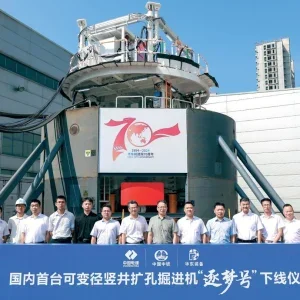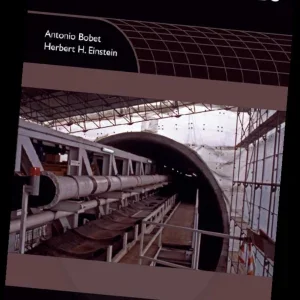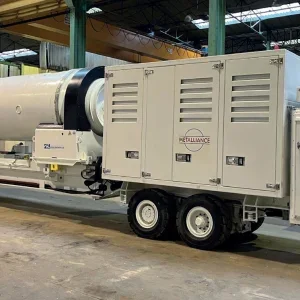Perth, capital city of Western Australia, has historically had ample space for infrastructure works because of its low population density. As a result, underground services were traditionally constructed using surface excavations that were cost effective and had minimal impact on the community. However, the city’s population of 1.4 million people is expanding, putting pressure on existing services.
The original Perth Main Sewer was constructed in the 1930s for the inner north western suburbs of the city. Some 70 years later, the 1.5m diameter gravity sewer of around 7km length served more than 300,000 residents as well as the central business district and was at the end of its serviceable life.
Now, six years into the Perth Main Sewer Replacement programme to construct a 2.1m diameter gravity sewer, the most challenging section is nearing completion.
Appointed by Water Corporation of Western Australia in 1998 to design and project manage Section 3, SMEC Australia investigated three main construction options: surface excavated pipeline, a combination of surface excavated pipeline and pipe jacking, and a combination of surface excavated pipeline and bored tunnel. Of major concern to WCWA was its path through the residential suburb of Wembley, and the bored tunnel option was chosen for its efficiency in sewer design, construction and minimal impact on the community.
The final route is 1.76km long, at a depth to sewer invert of between 2.6m and 18m, and a grade of 1 in 2,410. The first 400m of the sewer were laid by surface excavation using a combination of 2,100mm and twin 1,650mm diameter reinforced concrete pipes. The remaining 1,360m of 2.1m diameter sewer was constructed as a driven tunnel.
Project geology and tunnel alignment
The tunnel drive passed through coarse to fine sand densities varying from dense to loose. Although the limestone bedrock was located under the tunnel elevation, limestone pinnacles were encountered on two occasions during the excavation, which included a full face of competent limestone. The sand horizon extended fully to the surface. The final 260m of tunnel excavation entered the water table and the tunnel was fully submerged at breakthrough.
The tunnel alignment (see aerial photos) runs from Salvado Road, Subiaco to Lake Monger Drive, Wembley, a distance of 1,360m. The alignment includes seven 125m radius curves with a combined length of 373m. The tunnel passes primarily under residential and semi-arterial roads, but the route also takes it under nine private properties, four residential and one commercial building, a high pressure gas main and communication cables for international use.
Selection of tunnelling method
The main considerations when selecting the tunnelling method were:
– surface settlement/ground loss in the Perth sands
– groundwater in the last 250m of excavation – low ground cover (as low as 2.8m at both ends of the tunnel)
– the 125m radius curves
To minimise the risk of ground settlement in the Perth sands, SMEC’s specification for the contract specified the use of either a slurry TBM or earth pressure balance machine (EPBM) including the use of a ground conditioning system. This also had the advantage of removing the need to dewater the last 250m of tunnel.
The contract was awarded in November 1999 to Transfield Tunnelling, the specialist tunnelling division of Australian engineering and construction company Transfield, which had extensive soft ground tunnelling experience including the use of the both EPBMs and slurry TBMs.
Why use an EPBM?
Transfield’s first task was to procure an appropriate TBM for the project. An EPBM was preferred over a slurry machine for the following reasons:
– Concerns about slurry loss in the predominantly dry granular ground when using a slurry machine
– Transfield’s previous experience tunnelling in the Perth sands gave it confidence that the sand would stand up and that an EPB machine could be operated in open mode at an appropriate ground cover
– The EPBM would be less expensive to purchase and operate.
After considering a number of new and refurbished EPBMs, the contractor decided a new Lovat ME101SE series 19300 would be the most appropriate machine for the job. The supply contract was awarded to Lovat in January 2000 with a supply period to Perth of 27 weeks.
TBM design and features
The EPBM was designed and manufactured in Lovat’s Toronto facility in Canada.
The final design provided a cut diameter of 2.60m, TBM length (cutterhead and shields) of 6.95m and a total length of around 45m including the trailing backup. The weight of head and shield was 52t, with TBM and back up weight of approximately 88t.
The machine was powered by three 1,000V hydraulic motors with combined power of 360kW. The cutterhead bearing was a triple axial roller type driven by four reversible hydraulic motors with a maximum torque of 62t force.m.
Nine 65t force rams provided the propulsion with a combined maximum thrust of 580t and full stroke of about 1,700mm.
The cutterhead had a standard Lovat soft ground face design incorporating six flood doors, 13 face rippers, three gauge rippers, 12 face scrapers and three gauge scrapers.
An arm-type segment erector with ball and cup gripping mechanism was mounted off the screw conveyor for segment erection.
The TBM was fitted with a programmable logic controller for reading the operating sensors. The operating information was relayed via Man Machine Interface software to a Windows-type display in the operator’s cabin and also to a surface computer. This replaces the analogue gauges and manual controls of some earlier machines. A data logger was used to record all TBM operating information.
Other design features of the TBM included:
– A cutterhead with 2° articulation
– A ground conditioning injection system with injection ports located on the face (four) and cutterhead chamber (two). Screw conveyor ports (two)were later installed on site
– Trimate plate abrasion protection on cutterhead
– Access to the cutterhead through the bulkhead
– Flood doors providing the ability to change cutters from within the cutterhead
– Anti-roll device fitted to the forward shield
– Reduction in standard length of the trailing sleds to a maximum of 3m and telescopic trailing shield to negotiate the 125m radius curves (anti-roll mechanisms were later installed on the backup to prevent roll around the curves).
Tunnel construction
A 17m long x 4m wide x 6m deep sheet piled entry shaft was first constructed in Salvado Road. The sand behind the break-out wall was stabilised using microfine cement prior to cutting the exit hole in the sheet pile wall.
The TBM arrived on site on 8 August 2000, exactly 27 weeks after the order was placed. On arrival the cutterhead and forward shield were lowered together into the launching shaft, followed by the trailing shield.
Next in were the 12 sled sections containing the backup for the TBM, with the conveyor removed, which were pushed into the 2,100mm diameter pipeline that had previously been constructed.
Lovat supplied commissioning technicians who worked with the contractor’s mechanical and electrical personnel to install and commission the TBM.
Excavation started on 1 September, with the TBM and back-up being fully buried by 29 September. Because of the close proximity to residents (the entry shaft was within 10m of nearest dwelling) tunnel excavation was conducted on day shift only, between 7am and 5.30pm. A maintenance shift was carried out between 12 midday and 10pm.
Segmental precast concrete rings for ground support were designed by consulting firm Maunsell McIntyre and manufactured by CSR Humes in Perth. A standard EPDM gasket seal rated at 4 bar supplied by VIP Heinke was used with a spear bolt and socket connection from Tunnelling accessories.
Condat CLBF4/TM soap was chosen in the ground conditioning system throughout the tunnel excavation. The ground conditioning proved very effective in producing pluggable spoil suitable for controlling the cutterhead chamber pressure. The foam also reduced cutterhead torque and eliminated groundwater inflow while excavating through the water table.
The best ground conditioning results were produced with a very watery foam mix. Continual monitoring and alteration of the rate of total foam injection was required to prevent the spoil from drying out or becoming too wet. Pre-wetting the ground before each excavation cycle was also used to prevent the spoil from drying out.
All materials and excavated spoil was transported to/from the face on a rail system using 4t diesel powered locomotives. A permanent track was incorporated in the TBM trailing sleds, with a rail-up system in the last sled. A segment unloader was located in the first trailing sled.
Ground control and settlement
As the tunnel was excavated through a full sand horizon to the surface, controlling the ground to minimise settlement and eliminate any ground loss was critical. The solution was to alternate the TBM in full and partial EPB mode, while maintaining reasonable excavation times of 15-20min/m.
The TBM was operated in full EPB mode (ie full cutterhead chamber with chamber pressure equal to theoretical ground pressure) during the shallow sections of excavation, tunnelling through the water table and approaching and under buildings. Partial EPB mode was used while tunnelling at depth under public roads, to ensure negligible settlement.
Transfield work superintendent Rudi Spizzirri explained that the key to the project’s successful EPB operation was “the right choice of experienced operatives, maintenance team and the support of Lovat. It is essential that the whole project team knows the capabilities of the EPBM and the delicate nature of tunnelling under a residential area, especially in sand.”.
Muck volumes were continually monitored during the push and relevant information passed on to the shift supervisor and TBM operator. The mass of spoil excavated during each push was recorded while the muck cars were emptied at the entry shaft. This provided the contractor’s management team with early warning of any severe over-excavation and provided a record of any gradual increase or decrease of excavated volumes over time that could be addressed by the excavation crew.
A daily settlement monitoring regime was implemented during the tunnel excavation. This provided vital information to ensure that settlement was maintained within contract specification limits and gave early warning of any potential problems. At critical stages of excavation, such as under building and high-pressure gas mains, monitoring was carried out frequently throughout the day.
The settlement measured directly above the tunnel centreline typically varied from 15mm in the shallowest sections of tunnel above the water table to between zero and 5mm when the ground cover exceeded 7m.
TBM and project performance
On 14 May this year, some eight and a half months after the drive began, the TBM broke into the exit shaft to complete the tunnel excavation. This was achieved with operations carried out in day shifts only, five and a half days per week.
The Lovat EPBM performed extremely well, with mechanical and electrical breakdown accounting for just 4% of available production time (2% mechanical and 2% electrical) with no major breakdowns.
In addition to the daily maintenance shift, four scheduled maintenance and head inspection stoppages were conducted during the tunnel drive. Minimal wear was found on the gauge rippers, with generally no wear on the face rippers, even after excavating through the limestone pinnacles. Given the abrasive nature of sands this is a testament to use of the appropriate cutterhead design and foaming agents and the effectiveness of controlled operation when using EPBMs in granular soils.
After the start up period the average production rate was in excess of 50m per week (not including planned stoppages). The maximum weekly production was 63m for 5.5 shifts of 10.5 hours each.
Both client and contractor were extremely pleased with the outcome of the project. The client’s representative, Mike Bluck of SMEC stated: “This project has seen a commitment to the best aspects of partnering, which has resulted in no disputes and the best results for all parties. The technical solutions achieved have seen the 1.3km of major sewer works constructed with minimal disruption to the residents of Wembley”.
Related Files
Section






